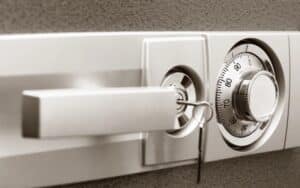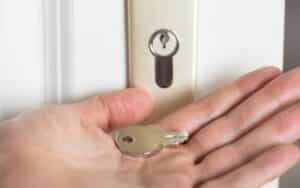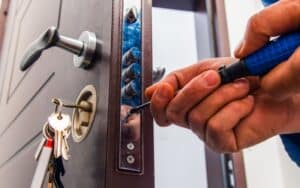Ever wrestled with a stubborn door lock that just won’t budge? Door locks, while small and often overlooked, play an essential role in our daily lives, keeping our homes secure and our possessions safe. Yet, when they start sticking, they can become a source of great frustration.
From dirt buildup to misaligned strike plates, various factors can make your door lock become sticky or difficult to operate. But don’t worry, there’s no need to call a locksmith just yet. With a little knowledge and the right tools, you can troubleshoot and fix common door lock problems yourself.
Table of Contents
ToggleUnderstanding Door Lock Sticking
Common Causes of a Sticky Door Lock
Sticky door locks aren’t just annoying – they’re a problem that can impact your home’s security. But what causes a door lock to become sticky in the first place?
- Dirt and Debris Buildup: Over time, dirt, dust, and other tiny particles can accumulate within the lock cylinder, affecting the internal mechanisms and causing stickiness. Each time the key enters the lock, it could potentially introduce more grime and debris inside.
- Lack of Lubrication: Just like gears in a machine, the parts inside a lock need lubrication for optimal performance. Absence of adequate lubrication could cause internal components to grind against each other, making the lock stiff and difficult to turn.
- Extreme Temperatures: In hot conditions, metals used in locks can expand whereas cold conditions can cause them to contract. This shift in size may misalign the lock and strike plate, causing sticky locks. Humidity and condensation can also corrode internal parts over time.
- Worn-Out or Broken Parts: Regular usage can cause the screws, latches, and other moving pieces inside a lock to loosen or even break. Damaged parts interfere with the smooth operation of locks. In some cases, it’s not the lock but a worn-out or bent key causing the problem.
- Misaligned Strike Plate: If the hole in the door frame, which receives the latch bolt or deadbolt, isn’t properly aligned, it can prevent proper engagement of the lock leading to stickiness. This often results from a warped or sagging door.
Implications of a Sticky Door Lock
Sticky door locks often beguile with their innocuous start. They might seem like a minor annoyance at first, but their implications can be serious if overlooked.
The primary concern is security. A sticky lock is typically a malfunctioning lock. It might not close properly, leaving your home vulnerable to break-ins. In some cases, it may have the opposite effect. What if the lock sticks when you need to make a quick exit from the house during emergencies?
Then there’s the risk of the key getting stuck in the lock, possibly breaking during the removal process. A broken key in a stuck lock – sounds like a nightmare, doesn’t it?
From a comfort perspective, constantly struggling with a sticky lock can be frustrating, especially during inclement weather. It wastes time and causes unnecessary stress.
Remember, ignoring a problem won’t make it go away. If your door lock is sticky, take time to investigate the possible causes and address them promptly to avoid bigger problems down the line.
Steps for Diagnosing a Sticky Door Lock
Checking the Key
Might the problem lie within the key itself? A bent key, even minimally, tampers with the precision of the lock’s functionality. For instance, you may be dealing with keys replicated from multiple copies, causing deformation over time. Attempt straightening a bent key using pliers, but bear in mind, a trip to a locksmith for a new cut might be necessary, especially if the bend is significant.
Checking the Lock
Next, turn your attention to the lock on your door. Observe any visible anomalies in the key barrel and surrounding screws. Loose or poorly fitting parts could prove detrimental to the lock’s functionality. Assess screws for tightness; these play an integral role in holding the lock and door handle steady.
Examining the Lock Barrel and Keyhole
Finally, we investigate the heart of the matter – the lock barrel and keyhole. Inspect for signs of dirt buildup, misaligned parts, or rust, which might impede the locking mechanism. The internal workings of a lock, being complex and delicate, warrant meticulous assessment. For instance, you can use a can of air, a brilliant tool for forcing accumulated grime out of your keyway. Once cleaned, apply a specialized lock lubricant like dry graphite powder. This simple action could just be the ultimate panacea for sticky locks.
Common Missteps in Dealing with a Sticky Door Lock
Frequently, individuals mismanage the handling of a sticky door lock. Indeed, it’s easy to rush to solutions without fully understanding the root causes. For instance, many lubricate the lock hastily, giving in to the temptation to use any oil-based substance, such as WD-40. Remember, the recommendation is to use a dry graphite powder or Teflon-based sprays. The choice matters because oil-based substances attract more dirt over time.
Another frequent misstep falls in the area of dirt removal. Before trying to fix a lock, a common mistake is not removing dirt and debris from the keyway. Compressed air plays an indispensable role in dislodging built-up gunk, while an old toothbrush can scrub your latch bolt clean.
Further, it’s important to ensure that the key is properly aligned. One needs to check the latch bolt’s alignment with the hole in the door frame. More often than not, sticky locks result from sagging or warped doors that misalign the strike plate.
Ironically, replacing the tubular latch first can be another common misstep. It’s essential to be certain that the latch is the problem before replacing it. Remember, replacing the latch might not solve the problem if the issue lies elsewhere.
Finally, don’t forget the influence of weather. Extreme temperatures can interfere with the functioning of door locks. Misalignment of the lock and strike plate often results from heat expansion or cold contraction.

How to Properly Fix a Sticky Door Lock
Best Lubrication Practices for a Lock
A common myth when dealing with sticky locks is the idea that any form of lubrication works well. But, the type of lubricant you choose makes a significant difference.
The optimal lubricants for locks are dry graphite powder and Teflon-based sprays. These substances don’t attract dirt, meaning they won’t exacerbate the problem by introducing more debris into the lock.
Here’s how to lubricate a lock effectively:
- Choose your lubricant: Opt for dry graphite powder or Teflon-based sprays as the best lubricants. They don’t attract dirt which can jam the lock again.
- Apply the lubricant: Insert the spray nozzle into the keyhole, or puff the powder directly, and apply the lubricant. Remember to use it sparingly – too much can attract debris.
- Work it in: Insert your key into the lock and gently turn it back and forth several times. This helps distribute the lubricant into all the nooks and crannies within the lock mechanism.
- Wipe away excess: Clean your key and the lock’s exterior to avoid any leftover lubricant attracting more dirt in the long run.
Cleaning a Dirty Lock
If your problem results from dirt and debris buildup, cleaning is an essential measure before any lubrication attempt. Here, compressed air proves a valuable tool. Using an air duster or a quick blast from an air compressor, you can dislodge the accumulated grime from the keyway. Following this, you might consider scrubbing the latch bolt with an old toothbrush to eliminate any remaining dirt.
So, to clean a door lock:
- Prepare your tools: Gather your compressed air source and an old toothbrush.
- Dislodge the dirt: Blow compressed air into the keyhole to remove any buildup inside.
- Scrub if necessary: Use an old toothbrush to scrub away any stubborn dirt from the latch bolt.
- Wipe clean: Wipe the exterior of the lock and your key clean to prevent reintroduction of dirt.
Ways to Prevent a Lock from Sticking
Regular Maintenance and Cleaning
It’s often said that prevention is better than cure, and door locks are no different. Regular cleaning and maintenance are the cornerstone of keeping your door lock in good shape. Grime, dirt, lint, and dust can slowly accumulate inside the lock cylinder and clogging can occur over time. How does one prevent such a situation? A can of compressed air or a trusty old toothbrush can become your favorite tool. A quick puff of air or a gentle scrub can help keep the lock dirt-free.
But what about the internal workings of the lock? Remember, these parts don’t need just any lubricant, but dry graphite powder or Teflon-based sprays. These helpers ensure smooth operations without attracting more dust.
Strategic Use and Duplication of Keys
Your key has a direct impact on your lock’s functionality. A worn-out key can contribute to a sticking lock or even damage the lock’s internal mechanism. It’s a good practice to have a set of spare keys. A duplicate key with perfect alignment helps distribute the usage and prolong the life of your lock.
Early Action and Proactive Measures
Let’s face it, no door lock lasts forever. Over time, the screws, latches, and other moving pieces inside locks can naturally show signs of wear and tear. But, it’s crucial not to ignore the signs. Whether it’s a stiff lock or a hard-to-turn knob, the first symptoms of trouble are your cue to take action. Checking the alignment, cleaning, lubricating, and even replacing components are all better options than facing a full-blown lockout situation.
When to Call a Professional Locksmith
Even though home repairs can feel rewarding, there’s a point where professional aid becomes essential, particularly with obstinate locks. Remembering the potential consequences of faulty locks, from security compromises to unforeseen repair costs, it’s crucial to identify when it’s time to phone in the pros.
If your lock resembles an obstinate pickle jar refusing to open after numerous attempts, it could signify a larger internal issue, something misaligned or damaged. In such cases, it’s advisable to get professional insight.
Secondly, door warping or sagging might present problems beyond sticky locks, such as misaligned strike plates. A locksmith’s expert eye can establish whether this is behind your lock troubles. Beyond adjusting locks, they can advise on whether door replacement would be judicious to ensure enduring lock health.
Finally, considering lock intricacy, an inexpert hand could unintentionally induce damage, notably when lock components need dismantling. Incorrectly returned parts or overtightened screws could precipitate more persistent issues than a sticking lock. When in doubt about your ability to successfully conduct repairs, a locksmith’s number should be on the speed dial.
To keep your access secure and your mind at peace, don’t hesitate to reach out to a professional locksmith when your lock-switching efforts prove futile. You might just save yourself further frustration and monetary stress in the long run. For expert help, consider contacting D & L Mobile Locksmith.






